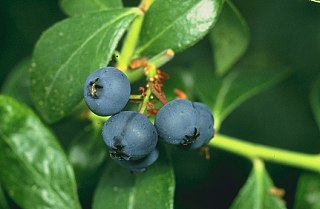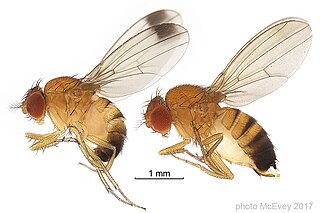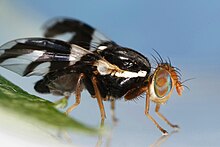
The Japanese beetle is a species of scarab beetle. The adult measures 15 mm (0.6 in) in length and 10 mm (0.4 in) in width, has iridescent copper-colored elytra and a green thorax and head. It is not very destructive in Japan, but in North America and some regions of Europe is a noted pest to roughly 300 species of plants, including rose bushes, grapes, hops, canna, crape myrtles, birch trees, linden trees, and others.

A railroad worm is a larva or larviform female adult of a beetle of the genus Phrixothrix in the family Phengodidae, characterized by the possession of two different colors of bioluminescence. It has the appearance of a caterpillar. The eleven pairs of luminescent organs on their second thoracic segment through their ninth abdominal segment can glow yellowish-green, while the pair on their head can glow red; this is due to different luciferases in their bodies, as the reaction substrate, called luciferin, is the same.

The Tortricidae are a family of moths, commonly known as tortrix moths or leafroller moths, in the order Lepidoptera. This large family has over 11,000 species described, and is the sole member of the superfamily Tortricoidea, although the genus Heliocosma is sometimes placed within this superfamily. Many of these are economically important pests. Olethreutidae is a junior synonym. The typical resting posture is with the wings folded back, producing a rather rounded profile.

The apple maggot, also known as the railroad worm, is a species of fruit fly, and a pest of several types of fruits, especially apples. This species evolved about 150 years ago through a sympatric shift from the native host hawthorn to the domesticated apple species Malus domestica in the northeastern United States. This fly is believed to have been accidentally spread to the western United States from the endemic eastern United States region through contaminated apples at multiple points throughout the 20th century. The apple maggot uses Batesian mimicry as a method of defense, with coloration resembling that of the forelegs and pedipalps of a jumping spider.

Juglans nigra, the eastern American black walnut, is a species of deciduous tree in the walnut family, Juglandaceae, native to North America. It grows mostly in riparian zones, from southern Ontario, west to southeast South Dakota, south to Georgia, northern Florida and southwest to central Texas. Wild trees in the upper Ottawa Valley may be an isolated native population or may have derived from planted trees.

Ammonium carbonate is a salt with the chemical formula (NH4)2CO3. Since it readily degrades to gaseous ammonia and carbon dioxide upon heating, it is used as a leavening agent and also as smelling salt. It is also known as baker's ammonia and was a predecessor to the more modern leavening agents baking soda and baking powder. It is a component of what was formerly known as sal volatile and salt of hartshorn, and produces a pungent smell when baked.

The codling moth is a member of the Lepidopteran family Tortricidae. They are major pests to agricultural crops, mainly fruits such as apples and pears. Because the larvae are not able to feed on leaves, they are highly dependent on fruits as a food source and thus have a significant impact on crops. The caterpillars bore into fruit and stop it from growing, which leads to premature ripening. Various means of control, including chemical, biological, and preventive, have been implemented. This moth has a widespread distribution, being found on six continents. Adaptive behavior such as diapause and multiple generations per breeding season have allowed this moth to persist even during years of bad climatic conditions.

The Queensland fruit fly is a species of fly in the family Tephritidae in the insect order Diptera. B. tryoni is native to subtropical coastal Queensland and northern New South Wales. They are active during the day, but mate at night. B. tryoni lay their eggs in fruit. The larvae then hatch and proceed to consume the fruit, causing the fruit to decay and drop prematurely. B. tryoni are responsible for an estimated $28.5 million a year in damage to Australian crops and are the most costly horticultural pest in Australia. Up to 100% of exposed fruit can be destroyed due to an infestation of this fly species. Previously, pesticides were used to eliminate B. tryoni from damaging crops. However, these chemicals are now banned. Thus, experts devoted to B. tryoni control have transitioned to studying this pests' behaviors to determine a new method of elimination.

The light brown apple moth is a leafroller moth belonging to the lepidopteran family Tortricidae.
Rhagoletis indifferens, the western cherry fruit fly, is a pest that lives only on cherries. The adult form of this insect is slightly smaller than a housefly, with white stripes across the abdomen, yellow markings near the base of the wings, and black markings on the wings. The larva, which is the stage of this insect's lifecycle that causes the actual damage to the fruit, is similar to a typical fly larva or maggot. Female flies lay eggs in the cherries, where the larvae feed for 1–2 weeks before exiting. Western cherry fruit flies damage fruit by feeding, in both the adult and larval stages.

Rhagoletis mendax is a species of tephritid fruit fly known by the common name blueberry maggot. The blueberry maggot is closely related to the apple maggot, a larger fruit fly in the same genus. It is a major pest of plant species in the Ericaceae family, such as blueberry, cranberry, and huckleberry. The larva is 5 to 8 mm long, apodous, and white with chewing mouthparts. Female adults are 4.75mm in length, males are slightly smaller. Both adults are mostly black in color with white stripes, orange-red eyes, and a single pair of clear wings with black banding. The adult female fly lays a single egg per blueberry, and when the larva hatches it consumes the fruit, usually finishing the entire berry in under 3 weeks and rendering it unmarketable. The larva then falls to the soil and pupates. Adult flies emerge, mate, and females oviposit when blueberry plants are producing fruit. Each female fly can lay 25 to 100 eggs in their lifetime.

The Tephritid Workers Database is a web-based database for sharing information on tephritid fruit flies. Because these species are one of the most economically important group of insect species that threaten fruit and vegetable production and trade worldwide, a tremendous amount of information is made available each year: new technologies developed, new information on their biology and ecology; new control methods made available, new species identified, new outbreaks recorded and new operational control programmes launched. The TWD allows workers to keep up-to-date on the most recent developments and provides an easily accessible and always available resource.

The light brown apple moth is a leafroller moth belonging to the lepidopteran family Tortricidae. The moth was confirmed to be present in mainland United States in 2007, principally along the West Coast. The State of California and the US Department of Agriculture quickly imposed quarantine measures and decided to use aerial spraying of cities with pesticides to try to eradicate the moth. This led to substantial public controversy and claims of adverse health effects. Aerial spraying was discontinued in 2008. Trapping, monitoring, and inspection efforts were reduced or eliminated in 2012 due to budget problems.

Blueberries are a widely distributed and widespread group of perennial flowering plants with blue or purple berries. They are classified in the section Cyanococcus within the genus Vaccinium. Vaccinium also includes cranberries, bilberries, huckleberries and Madeira blueberries. Commercial blueberries—both wild (lowbush) and cultivated (highbush)—are all native to North America. The highbush varieties were introduced into Europe during the 1930s.

A pheromone trap is a type of insect trap that uses pheromones to lure insects. Sex pheromones and aggregating pheromones are the most common types used. A pheromone-impregnated lure, as the red rubber septa in the picture, is encased in a conventional trap such as a bottle trap, Delta trap, water-pan trap, or funnel trap. Pheromone traps are used both to count insect populations by sampling, and to trap pests such as clothes moths to destroy them.

Drosophila suzukii, commonly called the spotted wing drosophila or SWD, is a fruit fly. D. suzukii, originally from southeast Asia, is becoming a major pest species in America and Europe, because it infests fruit early during the ripening stage, in contrast with other Drosophila species that infest only rotting fruit.
The northwestern U.S. state of Washington's economy grew 3.7% in 2016, nearly two and a half times the national rate. Average income per head in 2009 was $41,751, 12th among states of the U.S.

Anastrepha ludens, the Mexican fruit fly or Mexfly, is a species of fly of the Anastrepha genus in the Tephritidae family. It is closely related to the Caribbean fruit fly Anastrepha suspensa, and the papaya fruit fly Anastrepha curvicauda.
The Washington State Department of Agriculture (WSDA) is a cabinet-level agency in the government of Washington which regulates, advocates, and provides services for the state's agricultural industry. The agency was established in 1913 and is headquartered in Olympia, Washington. The current director of the WSDA is Derek Sandison.
Ronald John Prokopy was an American entomologist who was a specialist on the behavior and biology of Rhagoletis flies and approaches to their management in apple orchards.

















